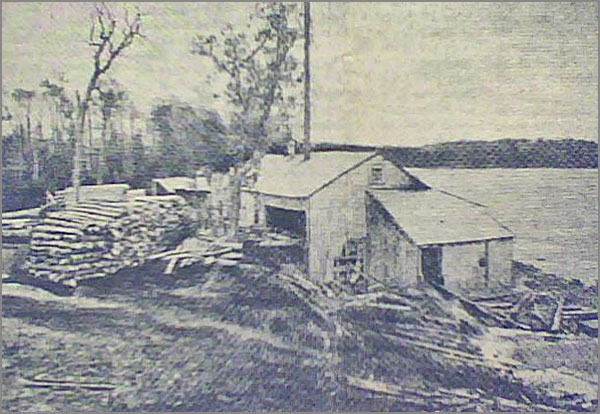Pre-Railway Communities / Turtle Mountain
| Old
Deloraine In 1880, when the government decided to place a Land Titles Office along the Boundary Commission Trail in the Turtle Mountain district, it put the new village of Deloraine on the map. Settlers seeking homestead in a huge area we might now call Southwest Manitoba had to travel there to get title to their new homes. A village quickly grew and as was common with all new settlements, settlers soon wanted a mill. In November 1882 brothers William and Thomas Sheppard built one along Turtlehead Creek adjacent to the new and growing village. It also made use of a Gouldie-McCulloch steam engine. This enterprise supplied the flour and feed needs of both local and North Dakota residents.  The region in 1884, with Postal and Stage routes. Waubeesh Another casualty of the Manitoba Boom was the settlement of Waubeesh, west of Boissevain. Settlers had big plans. A gristmill, whose wheel was to be turned by the water from Waubeesh Creek, was built by Robert John Hurt, and a huge celebration was held at its completion. Local histories tell us that, for unknown reasons the mill never ground a kernel of grain. A special edition of Northwest Farmer from 1883 indicates that: “The new grist mill at Waubeesh, Turtle Mountain, owned by Messrs. Brondgeest & Hurt, started up on the 19th of March, and is now in full operation. The mill structure in 36 x 64 feet, two storeys high, two run of stones, and is run by a twenty horse power engine.” (S: Nwfmm, Special Ed., 1883, p.20.) As often happened, especially in the era of the Manitoba Boom, the press tended to relate positive settlement stories, while lacking the resources, and sometimes the inclination, to fact check. We know for sure that the mill didn’t last long. Perhaps the progress in nearby Wakopa stifled the prospects of Waubeesh or the attention of speculators was turned towards the competing “Boom Town” of Turtle Mountain City, only a few kilometres away. Mr. Morton's Sawmill (Max Lake / McKinney / Conroy Sawmill) The Max Lake Sawmill also known as the Bolton Sawmill, it was built on Lake Max in 1881. It was bought by George Morton, then later owned by Hugh McCorquodale and then Bill Harvey. Then in 1910 Fred McKinney decided to buy the mill for him and his sons Doug, Bill, and Elson to run. They ran the mill till 1968. There are stories of men from all over going to the mill to get wood, men willing to go through days of travel and fighting a battle with the furiously cold weather. There was a bunk house where they could stay at night with a fireplace in the middle to keep it warm. The mill sat on the northern end of the lake, just west of a stream that flowed into the lake from a slough a couple hundred metres back from the shore. Cut logs were dumped into this slough. Afterwards, they were sent down a man-made channel to the lake where they were chained at the entrance to the lake from the stream. They were held here until there was room in the mill for them to be cut. The mill's boiler stack was guyed up to a majestic oak tree by a long bolt that went straight through the tree.  The sawmill on the edge of north shore of Lake Max, while it was owned by Mr. Morton. The machinery included a planer and shingle-mill. In about 1910 Harvey sold the sawmill to Fred McKinney, who moved it from Lake Max two miles north to his property. They used the mill to do a limited amount of custom sawing until the timber reserve was opened up again in 1930. Bill Eaket soon joined in the operation, lending the use of his gas-powered tractor to run the mill. Everything except for the actual sawing of the lumber was up to the customer to do. Trees were felled (by hand), trimmed and hauled (by horse) to the mill where they were sawed. The cost of this service was $10 to $12 per 1000 board feet.  Sawmill in the Turtle Mountain region. Photo courtesy Charlie Baldock In 1938 Bill Eaket dropped out of the operation and Bill and Doug took over the business from their father. They ran the mill for an additional 25 years. During this time they were mostly sawing for local farmers who needed lumber to construct buildings, corrals and hay shelters. |


